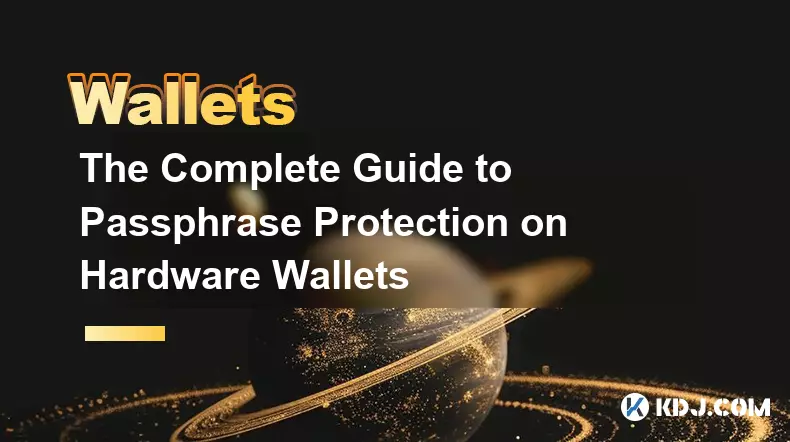-
 bitcoin
bitcoin $102877.190955 USD
1.88% -
 ethereum
ethereum $3430.435064 USD
4.52% -
 tether
tether $0.999264 USD
-0.05% -
 xrp
xrp $2.307310 USD
4.49% -
 bnb
bnb $987.740692 USD
3.82% -
 solana
solana $161.947760 USD
3.97% -
 usd-coin
usd-coin $0.999712 USD
-0.05% -
 tron
tron $0.292810 USD
2.93% -
 dogecoin
dogecoin $0.179738 USD
10.70% -
 cardano
cardano $0.580716 USD
8.75% -
 hyperliquid
hyperliquid $42.463448 USD
8.40% -
 chainlink
chainlink $15.763437 USD
7.05% -
 zcash
zcash $649.595636 USD
17.21% -
 bitcoin-cash
bitcoin-cash $511.610261 USD
7.19% -
 stellar
stellar $0.292537 USD
7.91%
The Complete Guide to Passphrase Protection on Hardware Wallets
A passphrase acts as a 25th word, adding robust security by creating hidden wallets and enabling plausible deniability on hardware wallets.
Nov 03, 2025 at 10:37 am

Understanding Passphrases in Hardware Wallets
1. A passphrase, often referred to as a 25th word, adds an additional layer of security beyond the standard 12 or 24-word recovery seed. Unlike the seed phrase, which is generated by the device, the passphrase is chosen entirely by the user and is not stored on the hardware wallet.
2. When enabled, the passphrase transforms the original seed into a completely different set of private keys and addresses. This means that even if someone gains access to your recovery seed, they cannot access your funds without the correct passphrase.
3. The concept operates on the principle of plausible deniability. Users can maintain multiple wallets from the same seed by using different passphrases—each passphrase unlocking a separate wallet with distinct balances and transaction histories.
4. Entering the wrong passphrase generates a different wallet altogether, one that may appear empty or contain decoy assets. This feature protects users during physical coercion scenarios where someone might be forced to reveal their wallet details.
5. It's critical to understand that losing the passphrase results in permanent loss of access to the associated wallet. There is no recovery mechanism—no customer support, no backup server—making memorization or secure offline storage essential.
How Passphrase Protection Enhances Security
1. Standard seed phrases protect against digital theft when stored securely, but they offer no defense if physically compromised. A passphrase introduces a knowledge-based second factor: something you know, in addition to something you have (the device).
2. Even with full possession of the hardware wallet and its recovery seed, attackers remain locked out without the correct passphrase. This shifts the attack vector from physical theft to psychological coercion, significantly raising the difficulty of unauthorized access.
3. In environments where privacy is paramount—such as high-net-worth individuals or those operating under oppressive regimes—passphrases allow for the creation of hidden wallets. These wallets are indistinguishable from regular ones and leave no forensic trace of their existence.
4. Firmware-level implementation ensures that the passphrase never leaves the device during entry. It is processed internally, preventing keyloggers or malware on connected computers from capturing it, provided the user enters it directly via the device’s buttons.
5. Multiple passphrases enable compartmentalization of funds. One could use a “daily” passphrase for small transactions and another for long-term savings, limiting exposure in case one environment becomes compromised.
Best Practices for Managing Passphrases
1. Avoid simple or predictable passphrases such as birthdays, pet names, or common words. Use a combination of uppercase, lowercase, numbers, and symbols to increase entropy and resistance to brute-force attacks.
2. Never store the passphrase electronically—this includes notes apps, cloud storage, screenshots, or encrypted files. Digital copies are vulnerable to hacking, malware, or accidental exposure.
3. Consider using a physical medium like a metal plate or fireproof document safe for storing the passphrase, kept separate from the recovery seed. Some users engrave passphrases onto titanium plates designed for crypto backups.
4. Test each passphrase setup immediately after creation in a safe environment. Confirm that the correct wallet loads with expected balances and that mistyping triggers a different, empty wallet.
5. Educate trusted family members or estate planners about the existence of a passphrase without revealing it directly. Use sealed envelopes or legal trusts to ensure continuity in case of incapacitation.
Frequently Asked Questions
What happens if I forget my passphrase?Forgetting the passphrase means permanent loss of access to the wallet it protects. No recovery option exists because the passphrase is not stored anywhere. Users must treat it with the same importance as the seed phrase itself.
Can I change my passphrase after setting it up?You cannot 'change' a passphrase in the traditional sense. Instead, you create a new wallet by entering a different passphrase. The original wallet remains accessible only with the original passphrase. Switching passphrases effectively switches between isolated wallets.
Is a passphrase the same as a PIN?No. The PIN protects physical access to the device and is entered every time the wallet is unlocked. The passphrase is optional and used during wallet derivation. Both are required together for full access, but they serve different cryptographic purposes.
Do all hardware wallets support passphrases?Most reputable models like Trezor, Ledger (via specific settings), and Coldcard do support BIP39 passphrases. However, functionality may vary—some require advanced mode to be enabled, and user experience differs across devices.
Disclaimer:info@kdj.com
The information provided is not trading advice. kdj.com does not assume any responsibility for any investments made based on the information provided in this article. Cryptocurrencies are highly volatile and it is highly recommended that you invest with caution after thorough research!
If you believe that the content used on this website infringes your copyright, please contact us immediately (info@kdj.com) and we will delete it promptly.
- Ripple (XRP) in 2026: Hold or Fold? A Look at XRP's Future and Emerging DeFi Alternatives
- 2025-11-08 18:35:01
- Zcash ZEC Coin Price Explosion: From Privacy Niche to Center Stage
- 2025-11-08 18:55:01
- Berachain Price Prediction: Navigating the Honeycomb Hype in Crypto
- 2025-11-08 18:55:01
- Arthur Hayes, Gold, and Bitcoin: A Modern Monetary Trinity?
- 2025-11-08 19:15:01
- Shiba Inu's Next Move: Navigating a Shifting Market
- 2025-11-08 19:20:01
- Pakistan's Crypto Crossroads: Balancing Opportunity with Asset-Backed Realities
- 2025-11-08 19:20:01
Related knowledge

How to use MetaMask Portfolio to track assets?
Nov 08,2025 at 05:40am
Getting Started with MetaMask Portfolio1. Download and install the MetaMask mobile app from the App Store or Google Play. Open the app and select 'Imp...

How to check your NFT collection in MetaMask?
Nov 06,2025 at 08:20pm
Accessing Your NFTs in MetaMask Wallet1. Open the MetaMask browser extension or mobile app and ensure you are logged into your wallet account. Once in...

Why is the MetaMask swap feature failing?
Nov 06,2025 at 09:20pm
Understanding MetaMask Swap FailuresMetaMask, one of the most widely used cryptocurrency wallets, enables users to swap tokens directly within the int...

How to update the MetaMask extension in Chrome?
Nov 08,2025 at 07:39am
Updating the MetaMask extension in Chrome is a simple process that ensures you have access to the latest security features, performance improvements, ...

How to import an account into MetaMask using a private key?
Nov 07,2025 at 07:40am
Importing an Account into MetaMask with a Private KeyMetaMask is one of the most widely used cryptocurrency wallets, particularly within decentralized...

What to do if my MetaMask wallet was compromised?
Nov 06,2025 at 04:59pm
Immediate Steps to Take After a Compromised MetaMask Wallet1. Disconnect your device from any phishing websites immediately. If you clicked on a suspi...

How to use MetaMask Portfolio to track assets?
Nov 08,2025 at 05:40am
Getting Started with MetaMask Portfolio1. Download and install the MetaMask mobile app from the App Store or Google Play. Open the app and select 'Imp...

How to check your NFT collection in MetaMask?
Nov 06,2025 at 08:20pm
Accessing Your NFTs in MetaMask Wallet1. Open the MetaMask browser extension or mobile app and ensure you are logged into your wallet account. Once in...

Why is the MetaMask swap feature failing?
Nov 06,2025 at 09:20pm
Understanding MetaMask Swap FailuresMetaMask, one of the most widely used cryptocurrency wallets, enables users to swap tokens directly within the int...

How to update the MetaMask extension in Chrome?
Nov 08,2025 at 07:39am
Updating the MetaMask extension in Chrome is a simple process that ensures you have access to the latest security features, performance improvements, ...

How to import an account into MetaMask using a private key?
Nov 07,2025 at 07:40am
Importing an Account into MetaMask with a Private KeyMetaMask is one of the most widely used cryptocurrency wallets, particularly within decentralized...

What to do if my MetaMask wallet was compromised?
Nov 06,2025 at 04:59pm
Immediate Steps to Take After a Compromised MetaMask Wallet1. Disconnect your device from any phishing websites immediately. If you clicked on a suspi...
See all articles





















![The Graph Price Prediction [GRT Crypto Price News Today] The Graph Price Prediction [GRT Crypto Price News Today]](/uploads/2025/11/07/cryptocurrencies-news/videos/690d4df44fe69_image_500_375.webp)



















































